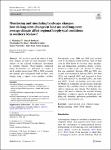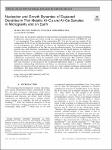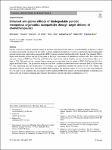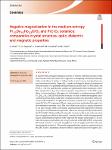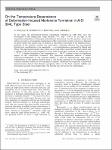Search
Author
- Osman, Ahmed I. (5)
- Daqing, Ma (3)
- Jorgensen, Ed (3)
- Li, Yan (3)
- next >
Subject
- kinh tế (26)
- Economics (12)
- programming (10)
- XRD (10)
- next >
Date issued
- 2020 - 2025 (2129)
- 2010 - 2019 (129)
- 2000 - 2009 (9)
- 1999 - 1999 (1)
Has File(s)
Search Results
We set out to reveal the effects of long-term changes in land use and long-term average climate on the regional biophysical environment in southern Malawi. Object-oriented supervised image classification was performed on Landsat 5 and 8 satellite images from 1990 to 2020 to identify and quantify past and present land use-land cover changes using a support vector machine classifier. Subsequently, using 2000 and 2010 land use-land cover in an artificial neural network, land use-land cover for 2020 driven by elevation, slope, precipitation and temperature, population density, poverty, distance to major roads, and distance to villages data was simulated. Between 1990 and 2020, area of land cover increased in built-up (209%), bare land (10%), and cropland (10%) and decreased in forest (3... |
The binary vanadium–nitrogen (V–N) coatings were formed using cathodic arc evaporation. Two sets of coatings were produced using: (a) nitrogen pressure (pN2) from 0.001 Pa to 3 Pa at a constant substrate bias voltage (UB) of − 100 V and (b) a substrate bias voltage from − 50 to − 300 V at a constant nitrogen pressure of 1.5 Pa. The influence of the above parameters on the coating properties, in particular on the insufficiently investigated and described adhesion of the coatings to the substrate, was demonstrated. The phase transformation V → V + V2N → V + c-VN → h-VN → h-VN + c-VN and c-VN → h-VN occurs for coatings formed with increasing nitrogen pressure and substrate bias voltage, respectively. With the increase in pN2 and UB, an increase in coating hardness and adhesion to the s... |
In this study, the nucleation and growth characteristics of equiaxed dendrites in near-isothermal solidification experiments, performed during two sounding rocket missions, MAPHEUS-6 and 7, are investigated. Two samples of the composition Al–15 wt pct Cu and one sample of the composition Al–46 wt pct Ge were processed in microgravity and several samples on ground. In situ X-radiography was performed to observe the nucleation dynamics and microstructure evolution during solidification of the 200 µm thin, disc-shaped samples. The measured dendritic growth rates and observed concentration distributions in the liquid indicate no difference between microgravity and on-ground horizontal experiments, in line with previous observations. |
Drum towers are the most prominent cultural markers and the major site for cultural ceremonies in Dong villages. The visibility and audibility of drum towers are important factors influencing the location and construction of buildings in Dong villages. In this paper, the authors map and classify 21 drum tower buildings according to three characteristics: shape of the plan, elevation of the enclosure, and aspect ratio of the longitudinal section. Having used the sound field simulation software Odeon to filter two of the three characteristics that were identical, the authors simulated drum towers with different values of the third characteristic to study the factors influencing their sound field. |
Zr-based bulk metallic glasses (BMGs) are characterized by excellent glass-forming ability, combined with superior mechanical properties. However, oxygen impurities degrade both these aspects as oxides serve as heterogeneous nucleation sites during solidification. Rare-earth elements (REEs) are known to be good oxygen scavengers, binding oxygen to less harmful forms. The most stable rare-earth oxide (REO) is M2O3, which occurs in three polymorphic forms, depending on the radius of metal cation: cubic, hexagonal, and monoclinic. Here, we show the effect of Sc, Y, Lu, Nd, and Gd additions in relation to the oxygen content on the glass-forming ability of the Zr52.5Cu17.9Ni14.6Al10Ti5 alloy. Microscopic observations (SEM) supported by chemical analysis (EDS, WDS), structure identificati... |
High-chromium cast irons are an essential class of wear-resistant materials commonly used for wear-resistant applications in the mining and steel industries. There is ongoing debate on the secondary carbide types and their formation sequences during heat treatment. This work examines the microstructural evolution during destabilization treatment of a hypoeutectic high-chromium cast iron containing 2.2 wt pct C and 16.5 wt pct Cr. Starting from an inhomogeneous as-cast microstructure consisting of ~ 28 pct M7C3 eutectic carbide and a mixed matrix of martensite and retained austenite, destabilization treatments resulted in the establishment of near homogeneous structure with a near equilibrium level of carbon concentration in the matrix, which fully transformed to martensite upon cool... |
Glioma is the most common malignant tumor of the brain and enhancing the efficacy of chemotherapy in glioma is critical for improving patients’ prognosis. In this study, a glioma-targeting drug delivery system is constructed using biodegradable periodic mesoporous organosilica nanoparticles (PMO) that are modified with lactoferrin (Lf) ligands. The obtained PMO is doped with thioether groups and can be degraded in the high concentration of glutathione in tumor cells. The surface area and pore volume of PMO are 772 cm2/g and 0.98 cm3/g, respectively and the loading capacity of doxorubicin (Dox) is as high as 20%. The results of the confocal laser scanning microscope show that the uptake of PMO-Lf@Dox by C6 cells is higher than PMO@Dox. |
In recent years, raising investigation activity in entropy-stabilized ceramic oxides has been driven by their innovative approach to designing a thermodynamically stable multi-element system, which provides a new focus on investigating complex functional materials. Especially, complex and singular physical properties of orthochromite have generated rising research in recent years. Of this family, the PrCrO3, DyCrO3, and HoCrO3 systems are particularly interesting since, below Néel temperature (TN), they present negative magnetization in the ZFC mode. Here, we have employed this approach and designed a medium-entropy (MECs) Pr1/3Dy1/3Ho1/3CrO3 (PDH) ceramic to study not only whether the magnetic characteristics prevail, but also the state of optical and dielectric properties of this ... |
Engineering nanotherapeutics have been extensively studied for cancer therapy. However, the therapeutic efficacy is still severely restricted by biophysiological barriers and intracellular accumulation. Although the biomimetic nanoparticles have improved the former issue, there is almost no breakthrough in researches of intracellular transport. Herein, we proposed a NIR-responsive nuclear-targeted hybrid membrane biomimetic Prussian blue drug-loading nanotherapeutics (PB@DN@M). |
In this study, the deformation-induced α-martensite formation in AISI 304L steel was investigated in the temperature range between 75 °C and − 196 °C in the light of the temperature-dependence of hydrogen embrittlement phenomena. For this purpose, tensile tests with in-situ and ex-situ magnetic measurement of the α-martensite volume content as a function of plastic strain were carried out. In addition, a theoretical assessment of the temperature-dependence of the austenite stability was undertaken, evaluating chemical and non-chemical driving force contributions to the martensitic γ → α transformation as proposed by Ghosh and Olson. |

